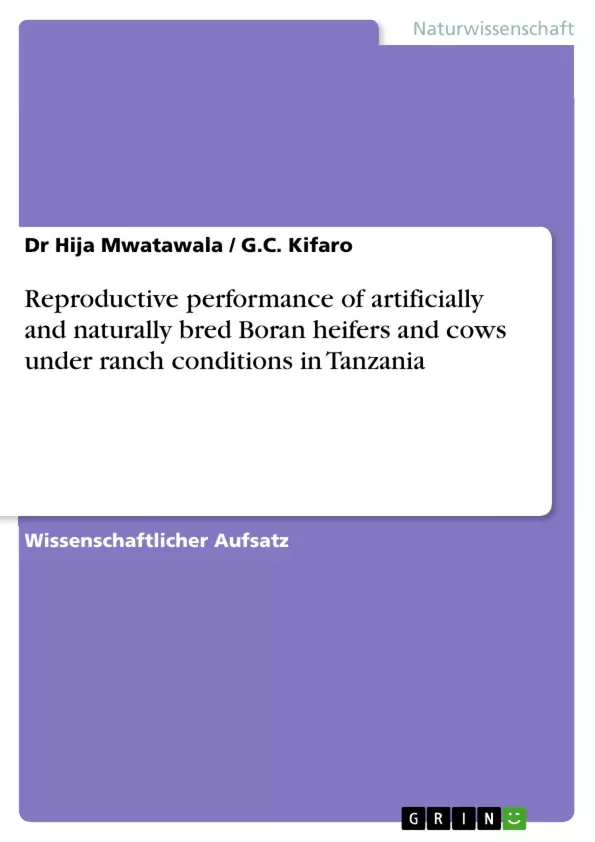This study investigated the influence of non-genetic factors on reproductive performance of
Boran cows and heifers reared under ranch conditions in Tanzania. Data on reproduction
performance were collected from Kikulula Heifer Breeding Unit (KHBU) in northwestern
Tanzania. Reproductive traits studied were age at first calving (AFC), calving interval (CI),
days open (DO) and number of services per conception (NSC). General Linear Models
(GLM) procedure of Statistical Analysis System (SAS) was used for data analyses. The
overall means for AFC, CI and DO were 42.2±0.23 months, 463.6±1.93 days and 183.4±1.93
days, respectively. AFC was significantly (P<0.001) influenced by year-season and type of
mating whereby heifers and cows bred in the late dry season performed better than those
bred in the heavy rain season. Heifers bred by natural service were about 4 months younger
at first calving than artificially bred ones. With regard to CI and DO, year-season of mating,
type of mating and parity were also important sources of variation. Cows that calved in the
heavy rain season had longest CI and DO than those calving in other seasons. The two traits
significantly decreased from first to fourth parity and then increased. Artificially bred cows
had poorer performance compared to those naturally bred. The overall mean for NSC for
both heifers and cows was 1.57±0.01. Parity, year-season of mating and type of mating
significantly (P<0.001) affected NSC. Heifers had the highest NSC (1.73) and were
decreasing with age till fourth parity. Further, cows and heifers mated in the dry season had
significantly more NSC than female cattle mated in the wet season; while artificially bred
animals had significantly higher (1.71±0.03) NSC than naturally bred ones (1.53±0.03). From
the findings, it is concluded that in order to improve reproductive performance,
environmental factors should be accorded more serious consideration.
Inhaltsverzeichnis
- Summary
- Introduction
- Materials and Methods
- Management of animals
- Data classification
- Data analyses
- Results
- Age at first calving (AFC)
- Calving intervals (CI) and days open (DO)
Zielsetzung und Themenschwerpunkte
Diese Studie untersucht den Einfluss nicht-genetischer Faktoren auf die Reproduktionsleistung von Boran-Kühen und -Jungkühen unter Ranchbedingungen in Tansania. Die Hauptziele sind die Analyse der Altersfaktoren beim ersten Kalben, des Kalbeintervalls, der Tage bis zur Trächtigkeit und der Anzahl der Besamungen pro Trächtigkeit. Die Ergebnisse sollen Aufschluss über die Optimierung der Reproduktionsleistung geben.
- Einfluss von Jahreszeit und Klima auf die Reproduktionsleistung
- Vergleich der Reproduktionsleistung zwischen natürlich und künstlich gezeugten Tieren
- Auswirkungen der Parität (Geburtsreihenfolge) auf die Reproduktionsleistung
- Analyse von Alter beim ersten Kalben (AFC), Kalbeintervall (CI) und Tage bis zur Trächtigkeit (DO)
- Anzahl der Besamungen pro Trächtigkeit (NSC)
Zusammenfassung der Kapitel
Die Studie analysiert die Reproduktionsleistung von Boran-Kühen und -Jungkühen unter Ranchbedingungen in Tansania. Das Kapitel "Materials and Methods" beschreibt detailliert die Datengewinnung und -auswertung, einschließlich der Haltungsbedingungen der Tiere und der statistischen Methoden. Der Abschnitt "Results" präsentiert die Ergebnisse der Analyse von Alter beim ersten Kalben (AFC), Kalbeintervall (CI) und Tage bis zur Trächtigkeit (DO), sowie die Anzahl der Besamungen pro Trächtigkeit (NSC), wobei der Einfluss von Jahreszeit, Paarungsart und Parität untersucht wird. Detaillierte statistische Auswertungen werden in Tabellen dargestellt.
Schlüsselwörter
Reproduktionsleistung, Boran-Rinder, Kalbeintervall, Alter beim ersten Kalben, künstliche Besamung, natürliche Besamung, Jahreszeit, Parität, Tansania, Reproduktionseffizienz.
- Quote paper
- Dr Hija Mwatawala (Author), G.C. Kifaro (Author), 2009, Reproductive performance of artificially and naturally bred Boran heifers and cows under ranch conditions in Tanzania, Munich, GRIN Verlag, https://www.grin.com/document/182201



